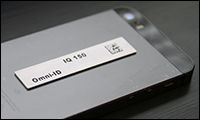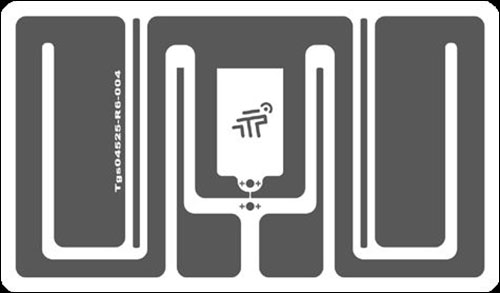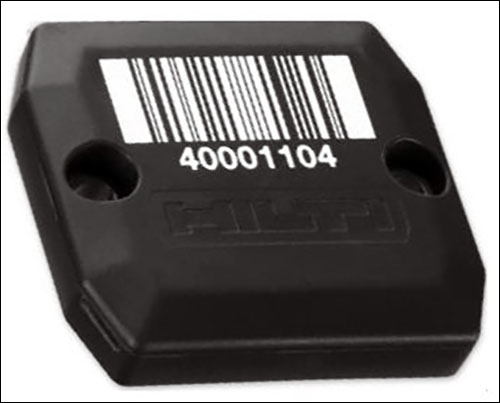The following are news announcements made during the past week by the following organizations:
Omni-ID;
Tageos;
Mojix;
Smartrac;
Hilti; and
Oak Labs.
Omni-ID Expands Line of Printable On-Metal RFID Labels
Omni-ID, a global supplier of industrial Internet of Things solutions, has announced the addition of five new products to its family of on-metal RFID labels: the IQ 100, IQ 150, IQ 300, IQ 500 and IQ 600. According to Omni-ID, its lineup of on-metal RFID labels offers smaller profile labels with 50 percent more read range than comparably sized competitive products, lower pricing (by 20 to 25 percent) compared with competitive products, and balanced, consistent performance, both on and off metal. The company says the new labels are suitable for monitoring IT and office assets, tools and kitchen assets, weapons, pipes and road signs, as well as for hospital tracking applications.
The IQ products support the EPC Gen2v2 RFID specification, Omni-ID reports, and have been designed and tested to provide compatibility with all leading thermal RFID printers. The company also offers additional memory, encoding, color printing and custom form factors. The labels’ construction is designed to provide reliable performance, according to the company, even when applied to curved surfaces in industrial applications, such as pipes and cylinders.
The IQ labels are available with Impinj‘s Monza R6 chip, which offers 96 bits of Electronic Product Code (EPC) memory, or the Monza 4QT tag chip, which has 96 bits of EPC memory and 512 bits of user memory.
The IQ 100 measures just 40 millimeters by 40 millimeters by 1 millimeter (1.6 inches by 1.6 inches by 0.04 inch) and weighs just 0.35 gram (0.01 ounce). The IQ 150 is ultra-thin, measuring 60 millimeters by 12.5 millimeters by 1 millimeter (2.4 inches by 0.5 inch by 0.04 inch) with a ground plane—60 millimeters by 12.5 millimeters by 0.9 millimeter (2.4 inches by 0.5 inch by 0.04 inch) without a ground plane—and weighing just 0.25 grams (0.009 ounce). Equally thin is the IQ 600, which measures 100 millimeters by 24 millimeters by 1 millimeter (3.9 inches by 0.9 inch by 0.04 inch) with a ground plane, or 100 millimeters by 24 millimeters by 0.9 millimeter (3.9 inches by 0.9 inch by 0.04 inch) without a ground plane. The IQ 600 is an upgrade from an earlier version, unveiled in 2012 (see Omni-ID Introduces Printable On-Metal RFID Labels). Not yet available, the IQ 300 has a 3-meter (9.8-foot) read range and a narrow form factor, and the IQ 500 has a global frequency and long read range.
The IQ 100, IQ 150 and IQ 600 are currently available, while the IQ 300 and IQ 500 are expected to be made available during the coming weeks. The company is now taking sample requests.
Tageos Updates EOS-220 RFID Label With Monza R6 Chips
RFID label manufacturer Tageos has announced two new versions its EOS-220 RFID label: one made with Impinj‘s Monza R6 RFID chip, with 96 bits of Electronic Product Code (EPC) memory; the other made with Impinj’s Monza R6-P chip, with up to 128 bits of EPC memory, as well as up to 64 bits of user memory. The EOS-220 is designed to address retailers’ small-item tagging needs.
Both versions, according to Tageos, feature a new antenna measuring 45 millimeters by 25 millimeters (1.77 inches by 0.98 inch), specially designed to meet customers’ requirements for a small yet high-performance RFID label. The EOS-220 measures 48 millimeters by 28 millimeters (1.9 inches by 1.1 inches) and is delivered as an adhesive label compatible with all standard available RFID thermal transfer printers, so that customers can encode the tags and print variable data and product information.
The EOS-220 is fully paper-based, the company reports, and is manufactured using Tageos’ patented inlay-less technology. By omitting the use of plastic-based inlays, Tageos explains, it is able to reduce the price of the finished label compared to inlay-based tags manufactured in a traditional manner. According to the company, its customers can benefit from a low-priced label while also meeting their green initiatives by using a product with a very low carbon footprint.
“Offering a small RFID label with best-in-class performance was our ambition when we started developing the EOS-220, but we wanted to provide to our customers a very cost-effective tag,” said Matthieu Picon, Tageos’ CEO, in a prepared statement. “Thanks to the high sensitivity of the Monza R6 chip, we came up with a very good product in terms of performance and reduced form-factor. Our EOS-220 is already being used by several clients in the retail industry.”
The EOS-220 is available immediately with Monza R6 and R6-P chips. Tageos will exhibit the new labels in its booth (#712) at this year’s RFID Journal LIVE! conference and exhibition, to be held in Orlando, Fla., on May 3-5.
Mojix Introduces STARflex RFID Reader
Mojix, a provider of wide-area ultrahigh-frequency (UHF) EPC Gen 2 RFID and Internet of Things (IoT) platform software, has announced its STARflex RFID reader. The STARflex reader is based on the company’s STAR RFID system architecture (see The Brightest Star), the company reports, and features a flexible new design optimized for cost-effective, easy-to-deploy solutions for enclosed environments, such as real-time inventory tracking in retail apparel, as well as patient-flow management in ambulatory health care.
STARflex is suitable for use in indoor RFID tracking applications in locations where reflections from metal shelves and fixtures obstructing the signal in line-of-sight (LOS) between the reader and tag can significantly reduce read rates, according to the company. STARflex uses antenna techniques designed for location tracking, Mojix says, is optimized for synthesizing waveforms in high-density tag environments, such as those found in retail stores, and uses a patented, distributed excitation architecture. This RFID technology, Mojix explains, assures reliable excitation and detection of all tags, wall-to-wall and floor-to-ceiling.
According to Mojix, its new reader can detect tag signals up to 100 times weaker than other RFID readers, and is suitable for any hands-free, real-time inventory- and location-tracking solution, such as Mojix’s recently announced OmniSenseRF Inventory Service for retail. Unveiled in January 2016, OmniSenseRF is an end-to-end, always-on, inventory-management solution available to retailers on a monthly service basis (see Mojix Offers OmniSenseRF Inventory Service for Retailers). OmniSenseRF delivers Mojix’s software and hardware as a service, and its benefits include painless software upgrades and maintenance, a pay-as-you-go model that reduces budget impact and eases financial planning, vendor-managed hardware, and integration with enterprise resource planning (ERP) software via a RESTful application programming interface (API). The solution also provides retailers with the ability to scale up an implementation seamlessly, Mojix reports, making it easier to plan and manage a chain-wide rollout.
The STARFlex reader, which measures approximately 13 inches by 7 inches by 2 inches, can be deployed as a substantially less expensive alternative to Mojix’s STAR 3000 RFID reader (see Mojix Announces Availability of Its Next-Generation RFID System).
Like the STAR 3000 RFID reader, Mojix says, the STARflex can be used with Mojix’s distributed excitation architecture (eNodes), which is a low-cost method of delivering very high performance over a large number of antennas. “But where the STAR was designed to be most economical for deployments of over 100 antennas,” explains Jim Donaldson, a spokesperson for Mojix, “the STARflex is optimized for smaller deployments, like small-box retail, individual departments in department stores, or ambulatory surgical centers.”
The STARflex can support 48 antennas with a few additional components. It supports up to 16 antennas without a Mojix eNode, but requires one eNode for each group of 16 additional antennas, for a total of two eNodes to support 48 antennas. The device requires only a single AC power connection and one network connection—enough for the real-time, overhead monitoring of a retail store measuring 3,000 to 6,000 square feet, depending on the requirements, Donaldson notes. In addition, Donaldson says, because it has a much higher sensitivity than a reader with an integrated antenna (at -100 dBm, up to 100 times more sensitive), it performs much better in environments containing a lot of reflective surfaces, such as metal shelves and fixtures.
The STARflex software architecture is optimized for simplicity and resilience, Mojix adds, in order to enable fast deployment of robust distributed systems. For tag data, STARflex features native support for the lightweight MQTT device protocol, developed for the IoT. To simplify and speed up integration, the reader features a RESTful interface for control and status. Users can implement business logic software directly on the reader using this RESTful interface, the company reports, or by utilizing the modern and ubiquitous node.js Web framework that enables the use of more than 200,000 open-source packages for easy integration with virtually any enterprise system.
The STARflex is available now.
Smartrac Makes Belt, DogBone Inlays With Ucode DNA and 7xm ICs
Smartrac has announced new Belt and DogBone inlays featuring NXP Semiconductors‘ Ucode DNA, 7xm and 7xm+ RFID chips. While retaining the features of the Belt and DogBone inlay ranges, the new ultrahigh-frequency (UHF) inlays offer extended memory or enhanced cryptographic security, according to the company. Each IC’s product characteristics are leveraged in the respective Smartrac Belt and DogBone inlays, Smartrac says, as they offer compact size and high performance, and are particularly suitable for automotive, industrial and supply chain applications.
NXP’s Ucode 7xm and 7xm+ chips, compliant with the EPC Gen 2 RFID standard, are designed for applications requiring extended memory, according to Smartrac. The 7xm contains 1024 bits of user memory, while the Ucode 7xm+ has 2048 bits. Both come with 448 bits of Electronic Product Code (EPC) memory. In addition, Smartrac indicates, the Ucode DNA UHF IC combines long-range read performance with cryptographic authentication.
Unveiled in April 2015, NXP’s Ucode DNA employs a dynamic password that changes with each read event, requiring the verification of each password from a server to prevent eavesdropping and tag cloning (see NXP Releases IC for Secure Encrypted UHF Reads).
Tags made with the Ucode DNA chip are secured with a unique and tag-specific crypto key, and can operate in a mode in which a tag’s response changes every time it receives a new read request from an RFID reader. The Ucode DNA IC is designed in accordance with the EPC Gen2v2 RFID standard, and the cryptographic authentication it uses is designed in accordance with the ISO/IEC 29167-10 standard for proof of origin, based on the Advanced Encryption Standard (AES). It comes with 3 kilobits of memory.
Hilti Offers RFID Solution to Help Construction Professionals Manage Tools
Hilti, a technology and solution provider for the construction industry, has launched a new ON!Track Asset Management solution designed to help construction professionals make the most of their assets and resources. The new Web-based service utilizes RFID technology from Confidex to trace tools, machines and equipment at various construction sites.
The solution is designed to help Hilti’s customers eliminate manual processes that can be inefficient and error-prone, the company explains, and replace them with real-time automated processes. Thus, customers will be able to optimize their use of assets by allocating the correct equipment to the right place at the proper time.
With Hilti ON!Track, a construction company can tag its tools, machines, materials or equipment with passive RFID tags made by Confidex. Each tag is marked with visual and bar-coded ID numbers.
The company then uses an RFID reader or smartphone to scan each tag’s RFID chip or bar code, the company explains, for quick and accurate identification of the equipment. The status of these assets is updated immediately to cloud-based data storage, Hilti says, thereby making the information readily available via the Internet or phone at any time.
Hilti’s tags and labels are being placed on hammer drills, cordless electric drills, power saws, laser levels, heavy angle drills, fasteners and other tools. Additionally, the ON!Track service is not limited only to Hilti-branded products, but may also be applied to any tools and construction machinery that need to be traced or tracked at the site.
Since these types of assets are handled very roughly in challenging environments, Hilti required highly durable labels and tags.
Hilti has been testing the RFID data-management solution with select key customers, and the system is now ready for a company-wide rollout.
Polo Ralph Lauren Store in Dallas Adopts Oak Interactive Fitting Room
Oak Labs has announced that the new Polo Ralph Lauren store at NorthPark Center, in Dallas, is now using its Oak Interactive Fitting Room, an RFID-enabled system that includes a touchscreen mirror to provide customers with an interactive experience while they try on apparel.
Oak Labs’ interactive and RFID-enabled system was first installed at the Polo Ralph Lauren stores in New York City, where it was put into eight fitting rooms (see Polo Ralph Lauren Store Gets Smart Fitting Rooms). The Oak Interactive Fitting Room uses an RFID antenna to detect tagged merchandise within the vicinity of a fitting room, and a touchscreen mirror recognizes the items and synchs with the store’s inventory-management system to produce images and product information on the screen, which is embedded in the mirror. The system requires no additional app that has to be installed on a customer’s phone, nor is there any camera in the mirror. Store personnel can communicate with a shopper in the fitting room via an Apple iPad app. The customer’s answers will then appear on the mirror.
The system works with any EPC Gen 2 ultrahigh-frequency (UHF) RFID tags. All integration with RFID is designed in-house and runs on the company’s own OakOS solution, a Linux variant system.
According to Oak Labs, the system helps retailers differentiate the in-store experience. Smart mirrors automatically identify all items that a customer has in the fitting room, and let him or her select and request new items, without having to leave the room. In addition, Oak Labs says, fitting-room space is a black box for retailers. According to the company, the Oak Interactive Fitting Room is designed to provide retailers with real, impactful metrics regarding products that enter fitting rooms, as well as which product variations are requested, fitting room and item-level conversions, and other information, to help them make smarter decisions across merchandising, buying, operations and beyond.
Oak Labs reports that it is currently exploring new use cases for RFID technology, in order to create other in-store customer experiences. This, the company adds, effectively takes RFID’s value proposition from the supply chain to every other corner of the retail organization.




